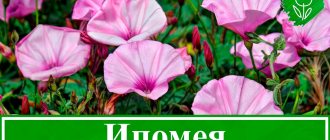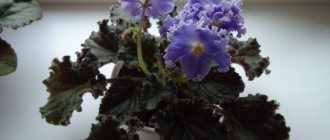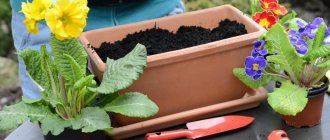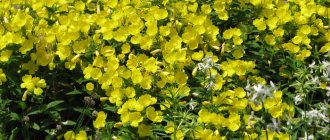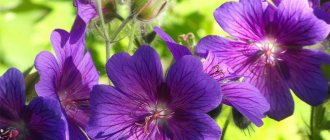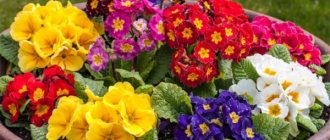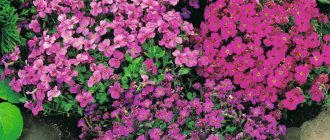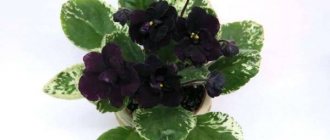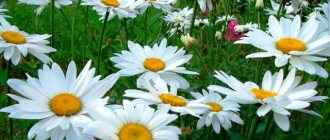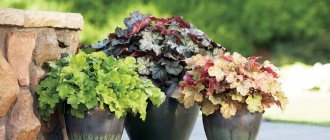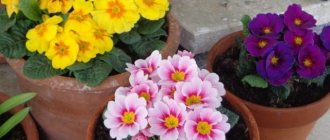Gaillardia is a plant of the Asteraceae family. The birthplace of this flower is America. It grows in the wild in Mexico and the southern United States. Named after Gaillard de Charenton, an eighteenth-century philanthropist who made major contributions to the development of botany.
This plant is the state symbol of Oklahoma. It grows in open areas and during the flowering period colors the fields in a bright fiery color.
Types and varieties of perennial and annual gaillardia: spinous and others
Both perennial and annual species and varieties of gaillardia are popular:
| Kinds | Description | Varieties | Description |
| Beautiful | Annual. An ornamental garden plant with one-color or two-color inflorescences - red at the base and yellow at the edges of the petals. | Red plume | Small flowers of rich red-pink color. |
| Lorenz | The inflorescences are large, with many petals. There are yellow and yellow-red varieties. | ||
| Pictha painted | Red or two-color inflorescences, large, spherical, with a large number of petals. | ||
| Yellow plume | Globular plants with yellow inflorescences, similar to the previous variety. | ||
| Blunt-toothed | Up to 70 centimeters high, with red-brown flowers. Rarely seen. | ||
| spinous | Perennial with dense straight stems, elongated or oval leaves. The flowers are reed-shaped, in rich warm shades. Flowering begins in early summer. | Mandarin | A variety of flower with bright red-orange inflorescences. |
| Wirral Flame | Red flowers with a thin yellowish border. | ||
| Dazzer | Two-color reed variety. | ||
| Hybrid | The result of mixing with other types of flowers. Depending on the variety, there are both tall (up to 80 cm) and short. | Primavera | Low, bushy plants with a large number of peduncles on one seedling. |
| Arizona Sun | Dwarf variety with a long flowering period. | ||
| Sonne | The height of the stem is up to 50-60 centimeters, there are inflorescences with tubular and reed petals. |
Similar in many ways to Helenium
Gaillardia is characterized by the presence of many corollas, thanks to which it perfectly decorates the flowerbed during flowering. Planting and caring for gaillardia in open ground largely depends on what kind of crop the grower prefers to cultivate - annual or perennial.
In the first case, it is necessary to create optimal conditions for beautiful gaillardia, and those who prefer perennials should learn the intricacies of cultivating hybrid and spinous gaillardia. However, one should not confuse gaillardia with helenium, which is quite reminiscent of it.
Growing gaillardia from seeds, when to plant
Growing from seeds occurs in two ways: seedlings or sowing directly into the ground.
The first method is divided into two stages: preparing seedlings and planting seedlings in the ground.
Sowing seeds for seedlings
Planting is carried out at the end of February or beginning of March. The seeds are not buried, but laid out on the surface of the soil and left in a bright room at room temperature.
The container with seedlings is placed in a place protected from sunlight. Water with a small amount of water as needed.
Gaillardia produces its first sprouts one to two weeks after planting.
Seedling care
After germination of the seedlings, the container with the seedlings is moved to a colder part of the room or to a greenhouse. The sprouts are separated from each other and placed in small containers when the third leaf appears.
Water young plants as the substrate dries. The sprouts must be exposed to light for at least 14 hours a day - you will need to install lamps to create the necessary lighting. The humidity in the room with seedlings should be kept moderate.
Planting gaillardia in open ground
Planting gaillardia does not cause any great difficulties, but you must follow small recommendations regarding planting dates, location and soil.
Landing dates
Strong sprouts are planted in the ground at the end of summer or in September. If planted correctly, the seedlings will have time to take root before the onset of frost and produce eight to ten strong leaves. The plant will bloom next spring.
If you sow flowers directly into the ground, without first growing seedlings, then the right time for sowing is the end of spring. The seeds are planted in shallow holes in the beds, and when the sprouts grow stronger and produce a third leaf, they are transplanted into a flower bed.
Disembarkation rules
Light areas and dry soil are suitable for this plant. The flower does not take root well in soil oversaturated with moisture. Before planting seedlings, the soil is fertilized with a mineral mixture. The concentration of the substance should be low - no more than 40 grams per 1 liter of water. The soil is also fertilized with ash. The distance between seedlings should be at least 20 cm.
Botanical characteristics
This garden flower grows up to 70 cm in height and forms a luxurious bush of bright buds. Each of them resembles a colorful basket with a miniature sun shining in the center. The inflorescences are held on flexible but long peduncles. The shoots are branched, slightly pubescent, covered with many alternate leaves. They are lanceolate or oval in shape. The edges are jagged, which emphasizes the originality of the flower. At the base of the bush there is a small rosette resembling a green blanket, which gives the plant a chic appearance.
Large and unusually pretty gaillardia flowers are distinguished by their rich and bright colors. The central part of them comes in different colors, but the edging is always yellow. The buds begin to bloom with the onset of summer and continue to delight their fans until the first frost. Interestingly, the inflorescences consist of reed and tubular petals, which have different colors. The extreme (reed) petals are:
- yellow;
- scarlet;
- orange;
- burgundy.
Those located in the center (tubular) are usually:
- dark brown:
- purple;
- light brown.
The center of the buds is velvety, embossed, which in combination with the petals looks especially attractive. The original baskets of the plant can be double or semi-double. In double varieties, the middle funnel-shaped flowers are especially developed. Semi-double specimens have 2 or 3 rows of reed petals, which look gorgeous against the background of the greenery of the plant. In the photo provided, gaillardia looks like a real queen in the garden.
The flower is grown not only in the garden, but also on the balcony or as a houseplant.
When the process of lush flowering ends, a seed ball remains on a high peduncle. It feels a little prickly and looks like a miniature brown hedgehog. Often such fluffy decorative cones are used to form compositions from dry plants.
To ensure that the plant always looks gorgeous in the garden, faded inflorescences should be plucked regularly.
Features of gaillardia care
Caring for these plants is not difficult.
Care Tips
To get healthy inflorescences, follow a few simple rules:
- Mineral fertilizers are used to feed gaillardia.
- During the season, fertilize the soil three times: at the beginning of flowering, in mid-summer and after the plant has flowered.
- Regularly loosen and weed the flowerbed. Water with a small amount of water and only in hot and dry weather when the soil becomes dry.
- Tall varieties of perennials require a garter.
Top dressing
To feed plants, mineral complexes such as Kemira universal are used. Compost and humus can also be used as fertilizer.
The main rule is that fertilizers should not increase the acidity of the soil. The use of manure can lead to the development of diseases and death of the plant.
Loosening is more important than watering
Planting perennials and cultivating them will not cause any difficulties. You just need to constantly ensure that the flowerbed is not covered with shadow by the foliage of the trees. In the presence of full illumination, other necessary conditions are formed by themselves.
To the question of how to water such a flowerbed, one can answer that it will only need water during a prolonged drought.
But even under such weather conditions, you should not moisten the soil abundantly. Much more attention should be paid to regular loosening while simultaneously removing weeds competing for light and moisture.
Gaillardia after flowering
Gaillardia blooms until the end of September. In October, seeds can be obtained from not removed peduncles.
How and when to collect gaillardia seeds
To collect seeds, flowers withered in summer are tied with tightly fixed gauze - this prevents unwanted seeds from falling into the soil. The inflorescences are left under gauze until the beginning of autumn, and then collected. A seed that falls naturally into the ground can also sprout in spring, so many gardeners do not resort to hand collection.
The seed method of propagating gaillardia is not popular. Plants grown using this method will differ from the mother plants and will not meet the standards of the variety. To preserve the appearance of the inflorescences, perennial varieties are planted using the bush method.
Preparing for winter
To prepare for winter, you need to separate all flowering shoots a few weeks before the first frost. If the gaillardia was planted only this year, you need to cut off all the stems and sprinkle the bush with dry straw.
Reproduction of gaillardia
Perennial varieties are propagated by the bush method. A strong and healthy bush, growing in one place for five years, is dug up and divided into two or three parts. Each of the shoots must be strong, with durable leaves, capable of taking root in a new bed. Division is carried out at the end of the season, when the plant has completely flowered. All parts are planted in new flower beds.
The root method of propagation is also possible. The large roots of a healthy plant are cut into pieces 5 cm long and then planted in a greenhouse.
Description of the plant
The bright flower grows along the road or sidewalks, on beaches and large clearings. During the flowering period of Gaillardia, the field seems to be on fire, because of this in English the plant is called “firewheel”, which translates as a wheel of fire. The shrub is noticeable from afar, as in the sun it glows with rich, variegated tones.
People have a legend about a flower, which says that in one of the kingdoms there lived a weaver. She knew how to create carpets of extraordinary beauty. People from all over the world came to her to buy carpets.
And in the neighboring kingdom there lived a woman who was not noticeable in any way. She envied the needlewoman from the neighboring kingdom, because all her attempts to make beautiful work were unsuccessful. The patterns turned out pale and gray. And then the girl bewitches the craftswoman.
It will be interesting to read about Solidago care.
After her magic, the craftswoman could no longer weave beautiful carpets, since she could not feel her hands. Soon the girl died.
When people came to the grave to honor the memory of the deceased, they were amazed. The entire grave was covered with a bright, beautiful carpet of gaillardia, which shone with a scarlet flame.
After this, the inhabitants of the kingdom began to take shoots of the fire plant and plant them in their yards, on roads and alleys. This way they managed to preserve the memory of the sweet girl and give joy to others.
Biological characteristics
The perennial Gaillardia has many names, which have changed since the plant's discovery. Today the flower has three main names: Gaillardia, Gaillardia, Gaillardia. The plant has more than 20 varieties, of which there are garden and wild forms.
The plant can be either annual or perennial. In appearance, the flower looks like a small massive bush, which does not reach more than 1 meter in length. There are also miniature options measuring 20-30 cm, which are quite popular in gardening.
The main biological characteristics are:
- Bush form;
- The leaves are simple oval in shape, with serrated edges;
- The flower resembles a plain or double texture;
- All inflorescences are located separately and have a golden-scarlet hue;
- There is no specific smell.
Gaillardia has abundant flowering, which forms an achene with a tuft. Single inflorescences bloom from June until the first frost. Long flowering allows gardeners to plant flowers both with other crops and alone.
The shrub blooms for no more than 5 years, then requires replanting.
Pests and diseases of gaillardia
The main cause of diseases is improper watering and excessively wet soil. The leaves of these flowers are susceptible to diseases such as:
- gray rot;
- rust;
- powdery mildew;
- spotty rashes.
Such diseases are caused by fungi. In the initial stages, the plant can be cured using fungicides (Fundazol, Skor). If the affected area is large, it is recommended to dig up and burn the diseased flower to prevent the fungus from spreading throughout the flowerbed. For preventative purposes, healthy flowers are treated with a solution of potassium permanganate.
The pests that most often cause damage to crops are aphids and whiteflies. Treating the flower bed with insecticides (Aktara, Aktellik) will help against them.
